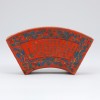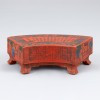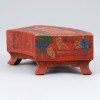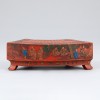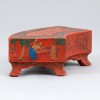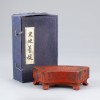본문
청대 부채꼴 형태의 붉은 바탕에 정교한 문양과 서예가 돋보이는 책상형 주사 먹입니다.
윗면 중앙에는 먹에 그려진 그림에 대한 찬사가(墨花讚) 행서체로 새겨져 있으며, 그 둘레에는 여의(如意)와 감 문양이 있습니다. 중국어로 일(事)과 감(枾)의 발음이 같기 때문에 감 문양은 일이 뜻하는 대로 풀리라는 의미를 갖습니다. 측면 세 면에는 문인들이 글씨를 쓰고 감상하거나 담소를 나누는 장면이 묘사된 동파논예도(東坡論藝圖)가 새겨져 있어 문인의 풍류와 예술적 교류를 상징합니다.
안쪽으로 휘어 들어간 면에는 부드러운 필치의 행서체 시문이, 책상 바닥 면에는 산수도(山水圖)가 있어 전체적인 구성을 더욱 풍부하게 합니다. 다리 부분에는 다산과 번영을 상징하는 석류, 장수와 건강을 상징하는 복숭아, 그리고 문인의 풍류를 상징하는 화로와 찻잔 등이 함께 그려진 박고도(博古圖)가 정교하게 나타나 있습니다.
이와 같은 책상형 먹은 문인이나 고위 관료 혹은 황실을 위한 용도로 제작되었을 가능성이 있습니다. 특히 황제나 황태자에게 올리는 진상용 먹 또는 문인, 고관, 과거 급제자에게 하사된 주사 먹으로 추정됩니다.
다음은 묵화찬의 내용입니다.
墨花讚(묵화찬)
먹그림을 칭찬함
固元斲雲玄趾(고원착운현지)
진실로 으뜸을 새기니 구름처럼 신비로운 자취
導貳團龍膏擣(도이단룡고도)
물길로 인도하여 용고를 모아 찧는다.
月桂羅三才搜(월계라삼재수)
월계를 펼쳐 삼재를 찾고
百禩天孫借巧工(백사천손차교공)
백번의 제사마다 천손은 장인의 솜씨를 빌린다.
倕䋵制妖感君(수예제요감군)
(黃帝 때의 훌륭한 장인) 倕는 급히 만들어도 요염하게 그대를 감동하게 하니
精謁帝韋誕顓(정알제위탄전)
정성으로 알현한 황제는 전궁의 탄생을 보면서
蒙奚超未濟玄(몽해초미제현)
어찌하여 초월하여 건너지 못했는가?
之玄進乎技寸餘(지현진호기촌여)
(玄之玄) 가물가물하는 재주를 가지고 나아가니
三千武昌市盛以(삼천무창시성이)
삼천여리 무창시가 성하므로
豹囊更重筍世(표랑갱중순세)
표낭 속 먹은 다시 죽순을 무겁게 하여
磨墨墨磨世(마묵묵마세)
(世磨墨墨磨世) 세상은 먹을 갈고 먹은 세상을 간다.
吳郡嚴澂(오군엄징) 雲松巢(운송소)
오군의 엄징 [운송소(雲松巢)]
- 吳郡嚴澂 만력 29년(1601) : 오군(吳郡)은 후한시대에 설치한 중국의 옛 군이름.
- 엄징(嚴澂, 1547~1625) 명나라 때의 거문고 명인. 자는 도철(道澈)이고 호는 천지(天池), 천지거사(天池居士), 운송소(雲松巢). 거문고의 곡조를 적은 악보 『송현관금보(松弦館琴譜)』를 저술했다. 시문(詩文)과 서법에도 능했던 그는 저서로 『운송소집(雲松巢集)』을 남겼다.
禗 - 제사 사, 귀신이 불안하여 가려할 사
倕 - 황제 때의 훌륭한 장인
䋵 - 급할 예, 비단을 찢을 알, 작은 마음 열
顓 - 전단할 전, 제 마음대로 할 전
- 표낭(豹囊): 표범 가죽으로 만든 주머니인데, 그 속에다 먹을 넣어두면 습기를 막을 수 있다. 《운선잡기(雲仙雜記)》에 “표낭에다 먹을 넣어둔 것은 습기를 타지 않기 때문이다.”라고 하였다.
此为清代呈扇形展开的桌案形朱砂墨,通体以红色为底,饰以精致纹样与书法。
墨的上表面中央行书刻有赞颂墨画的“墨花赞”,其周围则饰以如意纹与柿子纹。由于汉语中“柿”与“事”同音,柿子纹寓意万事如意、事事顺遂。三面侧边雕刻“东坡论艺图”,描绘文人书写、观赏、闲谈的情景,象征文人间的风雅与艺术交流。
内凹部分刻有行书体的诗文,笔触柔和流畅。底部则饰以山水图,使整体构图更为丰富、层次分明。桌腿处雕刻有象征多子多福的石榴、长寿与健康的桃子,以及文人风雅生活的香炉与茶盏等图案,构成一幅精美的博古图。
如此制作精美的桌案形墨,极有可能为文人、达官贵人或皇室成员所用,亦可能作为贡品进献给皇帝或太子,或赐予中进士者,以示荣宠。
以下为《墨花赞》全文内容:
墨花讚
固元斲雲玄趾
導貳團龍膏擣
月桂羅三才搜
百禩天孫借巧工
倕䋵制妖感君
精謁帝韋誕顓
蒙奚超未濟玄
之玄進乎技寸餘
三千武昌市盛以
豹囊更重筍世
磨墨墨磨世
吳郡嚴澂
雲松巢
注释
- 吴郡严澂:万历二十九年(1601年):吳郡是中国古代的郡名,始设于东汉。
- 严澂(1547–1625年),字道澈,号天池、天池居士、云松巢,明代著名琴师,兼擅书法与诗文。著有古琴谱《松弦馆琴谱》,并辑有文集《云松巢集》。
字词注解
禗:古代祭祀鬼神或祖先,安抚不安之神灵或亡灵而设的祭礼。
倕:传说中黄帝时的能工巧匠,擅长制作器物,以巧技著称。
䋵:表示急迫之意,从“糸”(丝),“曳”声。
顓:有“专断”、“自作主张”之意。
- 豹囊:以豹皮制成的囊袋,用以储墨防潮。见于《云仙杂记》:“以豹囊藏墨,墨不受湿。”
This table-shaped cinnabar ink stick from the Qing Dynasty features a rich red fan-shaped surface adorned with intricate patterns and striking calligraphy.
At the center of the top surface is an inscription in semi-cursive script praising the painting on the ink stick, known as known as Mòhuāzàn (墨花讚, “In Praise of Ink Painting”). Around it are ruyi (如意) and persimmon motifs. In Chinese, the words for "matter" (事) and "persimmon" (柿) are homophones, so the persimmon motif conveys a wish for matters to unfold smoothly as desired.
On three sides of the ink stick is a relief of the scene titled Dongpo Discussing the Arts (東坡論藝圖), which depicts literati writing, appreciating art, or engaged in leisurely conversation. This scene symbolizes the refined tastes and artistic exchanges of traditional scholars.
The inward-curving face of the table bears a semi-cursive calligraphic inscription in gentle strokes. The base surface of the table is decorated with a landscape painting, enhancing the overall artistic richness of the piece.
The legs are elaborately carved with a Bogu motif (博古圖), featuring elements such as pomegranates (symbolizing fertility and prosperity), peaches (symbolizing longevity and health), and scholar’s items like a brazier and teacups—representing refined scholarly leisure.
Such a table-shaped ink stick was likely made for use by literati, high-ranking officials, or the imperial court. It is believed that it may have been a tribute item for the emperor or crown prince, or a bestowed gift for scholars, officials, or civil service examination laureates.
The following is the text of Mòhuāzàn (墨花讚)
In Praise of Ink Painting
固元斲雲玄趾
Truly, the finest is carved, leaving mysterious traces like drifting clouds.
導貳團龍膏擣
The water channels guide the pressing of dragon ink paste.
月桂羅三才搜
Like laurel branches under the moon, the Three Talents are sought.
百禩天孫借巧工
In every ancestral rite, imperial descendants borrow the artisan’s skill.
倕䋵制妖感君
Chui, the master craftsman of the Yellow Emperor’s time, though rushed, crafted enchantingly to move the noble.
精謁帝韋誕顓
Sincerely presenting to the Emperor, he celebrates the birth of the sovereign’s domain.
蒙奚超未濟玄
Why then did he not cross the mysterious divide, transcending?
之玄進乎技寸餘
Yet he advanced with delicate skill, inch by inch, toward the mysterious.
三千武昌市盛以
Three thousand li away, Wuchang Market thrives in splendor.
豹囊更重筍世
Ink sticks in leopard pouches grow heavier than bamboo shoots in the world.
磨墨墨磨世
The world grinds ink, and ink grinds the world.
吳郡嚴澂 (雲松巢)
Yan Cheng of Wu Prefecture [Yunsongso]
Notes:
- Yan Cheng of Wu Prefecture, 29th year of the Wanli reign (1601): Wu Prefecture (吳郡) was an ancient administrative district established during the Eastern Han Dynasty.
- Yan Cheng (嚴澂, 1547–1625): A celebrated zither master of the Ming Dynasty. His courtesy name was Dào chè (道澈), and his pen names included Tianchi (天池), Tianchi Jushi (天池居士), and Yúnsōngcháo (雲松巢). He compiled the guqin score Sōngxiánguǎnqínpǔ (松弦館琴譜), and was also accomplished in poetry and calligraphy, leaving behind the literary collection Yunsòngsojíp (雲松巢集).
禗 (Sī): A sacrificial rite held to appease restless or uneasy spirits.
倕 (Chui): A legendary craftsman during the Yellow Emperor's reign, known for his exceptional skill.
䋵 (Yei): A rare character implying urgency or hurried craft (composed of silk and small-heart radicals).
顓 (Jeon): Denotes acting on one's own will or without restraint.
Leopard Pouch (豹囊): A pouch made from leopard skin, traditionally used to store ink sticks and protect them from moisture. According to Unseonjapgi (雲仙雜記), “Ink stored in a leopard pouch is not affected by moisture.”

